Top Rankings
Nashoba Valley Regional Vocational Technical School District ranks among the top 20% of public school district in Massachusetts for:
Category
Attribute
Graduation Rate
Highest graduation rate (Top 20%)
For the 2025 school year, there is 1 public school serving 773 students in Nashoba Valley Regional Vocational Technical School District. This district's average testing ranking is 6/10, which is in the top 50% of public schools in Massachusetts.
Public School in Nashoba Valley Regional Vocational Technical School District have an average math proficiency score of 42% (versus the Massachusetts public school average of 42%), and reading proficiency score of 52% (versus the 45% statewide average).
Minority enrollment is 23% of the student body (majority Hispanic), which is less than the Massachusetts public school average of 47% (majority Hispanic).
Overview
This School District
This State (MA)
# Schools
1 School
1,837 Schools
# Students
773 Students
916,334 Students
# Teachers
67 Teachers
77,716 Teachers
Student : Teacher Ratio
12:1
12:1
District Rank
Nashoba Valley Regional Vocational Technical School District, which is ranked within the top 50% of all 393 school districts in Massachusetts (based off of combined math and reading proficiency testing data) for the 2021-2022 school year.
The school district's graduation rate of 95% has stayed relatively flat over five school years.
Overall District Rank
#169 out of 397 school districts
(Top 50%)
(Top 50%)
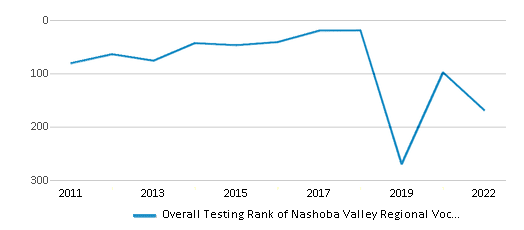
Math Test Scores (% Proficient)
40-44%
41%
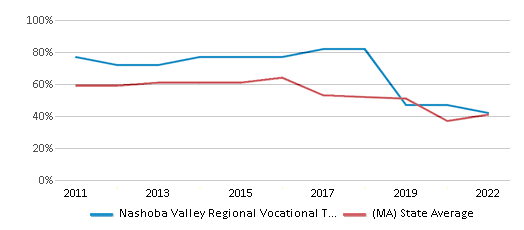
Reading/Language Arts Test Scores (% Proficient)
50-54%
44%
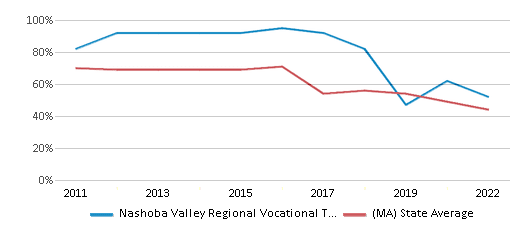
Science Test Scores (% Proficient)
35-39%
44%
Graduation Rate
≥95%
90%
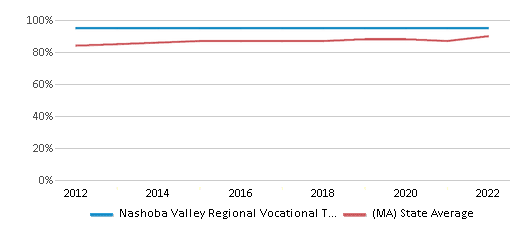
Students by Ethnicity:
Diversity Score
0.39
0.65
# American Indian Students
1 Student
2,192 Students
% American Indian Students
n/a
n/a
# Asian Students
9 Students
67,818 Students
% Asian Students
2%
7%
# Hispanic Students
98 Students
230,769 Students
% Hispanic Students
13%
25%
# Black Students
18 Students
88,074 Students
% Black Students
3%
10%
# White Students
595 Students
483,656 Students
% White Students
77%
53%
# Hawaiian Students
n/a
785 Students
% Hawaiian Students
n/a
n/a
# Two or more races Students
32 Students
41,339 Students
% of Two or more races Students
5%
5%
Students by Grade:
# Students in PK Grade:
-
32,288
# Students in K Grade:
-
62,105
# Students in 1st Grade:
-
64,458
# Students in 2nd Grade:
-
66,664
# Students in 3rd Grade:
-
64,731
# Students in 4th Grade:
-
65,978
# Students in 5th Grade:
-
67,142
# Students in 6th Grade:
-
67,086
# Students in 7th Grade:
-
68,011
# Students in 8th Grade:
-
68,221
# Students in 9th Grade:
214
73,757
# Students in 10th Grade:
199
73,439
# Students in 11th Grade:
193
71,886
# Students in 12th Grade:
167
68,770
# Ungraded Students:
-
1,798
District Revenue and Spending
The revenue/student of $28,508 is higher than the state median of $23,845. The school district revenue/student has declined by 6% over four school years.
The school district's spending/student of $22,132 is less than the state median of $24,602. The school district spending/student has declined by 6% over four school years.
Total Revenue
$22 MM
$21,850 MM
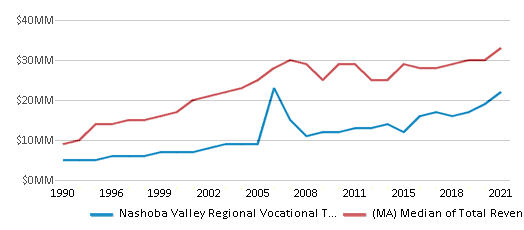
Spending
$17 MM
$22,544 MM
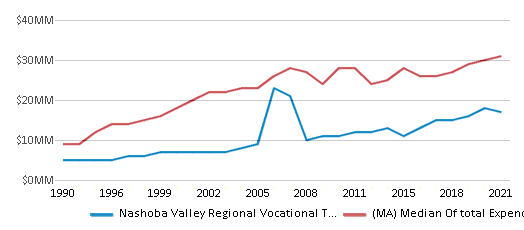
Revenue / Student
$28,508
$23,845
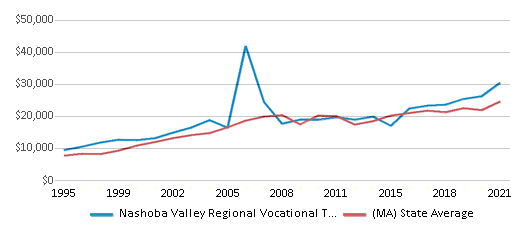
Spending / Student
$22,132
$24,602
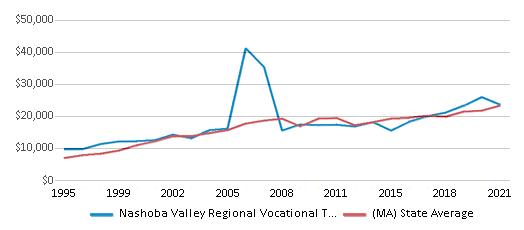
Best Nashoba Valley Regional Vocational Technical School District Public Schools (2025)
School
(Math and Reading Proficiency)
(Math and Reading Proficiency)
Location
Grades
Students
Rank: #11.
Nashoba Valley Technical High School
Vocational School
(Math: 40-44% | Reading: 50-54%)
Rank:
Rank:
6/
Top 50%10
100 Littleton Road
Westford, MA 01886
(978) 692-4711
Westford, MA 01886
(978) 692-4711
Grades: 9-12
| 773 students
Frequently Asked Questions
How many schools belong to Nashoba Valley Regional Vocational Technical School District?
Nashoba Valley Regional Vocational Technical School District manages 1 public schools serving 773 students.
What is the rank of Nashoba Valley Regional Vocational Technical School District?
Nashoba Valley Regional Vocational Technical School District is ranked #167 out of 393 school districts in Massachusetts (top 50%) based off of combined math and reading proficiency testing data for the 2021-2022 school year. This district ranks in the top 20% of Massachusetts school districts for: Highest graduation rate (Top 20%)
What is the racial composition of students in Nashoba Valley Regional Vocational Technical School District?
77% of Nashoba Valley Regional Vocational Technical School District students are White, 13% of students are Hispanic, 5% of students are Two or more races, 3% of students are Black, and 2% of students are Asian.
What is the student/teacher ratio of Nashoba Valley Regional Vocational Technical School District?
Nashoba Valley Regional Vocational Technical School District has a student/teacher ratio of 12:1, which is equal to the Massachusetts state average of 12:1.
What is Nashoba Valley Regional Vocational Technical School District's spending/student ratio?
The school district's spending/student of $22,132 is less than the state median of $24,602. The school district spending/student has declined by 6% over four school years.
Recent Articles

Year-Round Or Traditional Schedule?
Which is more appropriate for your child? A year-round attendance schedule or traditional schedule? We look at the pros and cons.

Why You Should Encourage Your Child to Join a Sports Team
Participating in team sports has a great many benefits for children, there is no doubt. In this article you will learn what those benefits are.

White Students are Now the Minority in U.S. Public Schools
Increasing birth rates among immigrant families from Asia and Central and South America, combined with lower birth rates among white families, means that for the first time in history, public school students in the United States are majority-minority. This shift in demographics poses difficulties for schools as they work to accommodate children of varying language abilities and socio-economic backgrounds.





